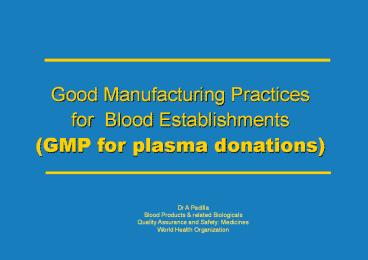Guidelines - PowerPoint PPT Presentation
1 / 28
Title:
Guidelines
Description:
Good Manufacturing Practices for Blood Establishments (GMP for plasma donations) Dr A Padilla Blood Products & related Biologicals Quality Assurance and Safety: Medicines – PowerPoint PPT presentation
Number of Views:103
Avg rating:3.0/5.0
Title: Guidelines
1
Good Manufacturing Practices for Blood
Establishments (GMP for plasma donations)
Dr A Padilla Blood Products related
Biologicals Quality Assurance and Safety
Medicines World Health Organization
2
OUTLINE
OUTLINE
- The GMP concept
- Good Manufacturing Practices for BE
- GMP compliance
- Impact of QA/GMP approach
- Website references
3
GMP IN BLOOD ESTABLISHMENTS
- GMP addresses the manufacturing activities
(collection, testing, process, storage,
labelling, distribution) of the blood
establishment - Implementation of GMP requires to separate
medical functions from manufacturing activities
(e.g. plasma) in blood establishments
GMP applies to products and processes
4
WHA63.12 "Blood Products" definition
"Any therapeutic substances derived from human
blood, including whole blood, labile blood
components and plasma-derived medicinal products"
5
WHAT DO WE NEED TO ACHIEVE THROUGH GMP?
- CONTROL INHERENT BIOLOGICAL VARIABILITY
- CONSISTENCY OF PRODUCTION/PROCESSES
- TRACEABILITY DONOR RECIPIENT
each individual donation is unique
6
HOW TO MANAGE THIS?
- To control the high variability, we need proof of
a robust collection and production process - To control the process, we need a systematic
approach (the QA/GMP approach) to ensure
compliance at all steps involved - To apply the systematic production approach, each
intermediate and final product must fulfil
defined quality requirements pre-defined
validated specifications
7
GMP A TOOL TO CONTROL PROCESS VARIABILITY
- important to understand which characteristics are
most relevant, and their impact, on products and
processes - measurable characteristics
- trend analysis to observe processes
- effective change control mechanisms
human plasma has intrinsic biological
variability
8
TRACEABILITY FROM DONOR TO PATIENT
FRACTIONATION VIRAL INACTIVATION
DONOR INFORMATION
COMPONENTS SEPARATION
TREATMENT
Good Manufacturing Practices
9
TRACEABILITY FROM DONOR TO PATIENT
Blood/Plasma donation
Blood Components
Patients
Plasma-Derived Medicinal Product
Plasma for Fractionation
- COMPONENTS PREPARATION, e.g.
- production process
- testing
- process control
- release
- storage transport
- DONOR/DONATION
- donor population
- donor registration
- donor selection
- donor protection
- collection process
- FRACTIONATION, e.g.
- fractionation process
- viral inactivation
- QC release
- distribution
10
TRACEABILITY IS KEY
- unique donor/donation number
- clear identification of donor, donation, products
- post donation information
- effective information system between blood
establishment, testing lab, hospital or plasma
supplier and fractionation plant - must work in both ways donor-patient-donor
11
Plasma Contract Fractionation Programs- Need for
GMP implementation in BE -
GMP- common principles
GMP Licensing
Quality Assurance Program
GMP Licensing
Plasma Contract fractionation
across countries
12
FROM DONOR TO PATIENT
FRACTIONATION VIRAL INACTIVATION
COMPONENTS PREPARATION
COLLECTION PROCESS
TREATMENT
TRACEABILITY LOOK BACK SYSTEM
13
Good Manufacturing Practices (GMP) for Blood
establishments (BE) Definition
GMP is that part of QUALITY ASSURANCE that
ensures that products are consistently produced
to the quality standards appropriate to their
intended use, as required by predefined
specifications and, if applicable, by the
marketing authorisation. GMP is concerned with
both production and quality control. WHO
Guidelines for Blood Establishments (TRS 961,
Annex 4) http//www.who.int/entity/bloodproducts/
publications/GMP_Bloodestablishments.pdf
14
GMP compliance issues specific to the production
of blood components, including plasma for
fractionation
15
WHO GMP Guidelines contain...
- .. general GMP topics, e.g. quality management
- .. specific topics to manufacturing of blood
components, from donor selection through
distribution of final product - .. newer GMP concepts, e.g. risk management,
product quality reviews
16
Structure of the Document
- Chapters 1































